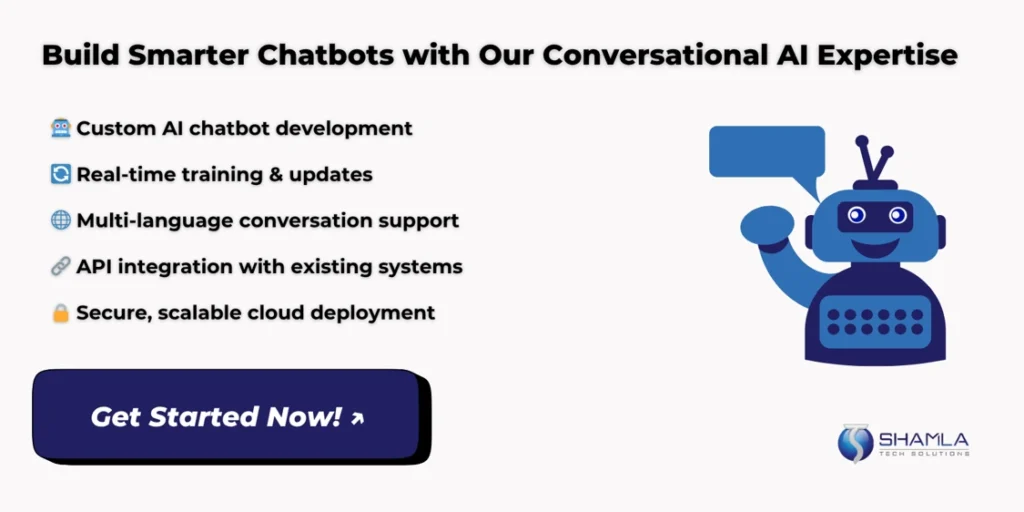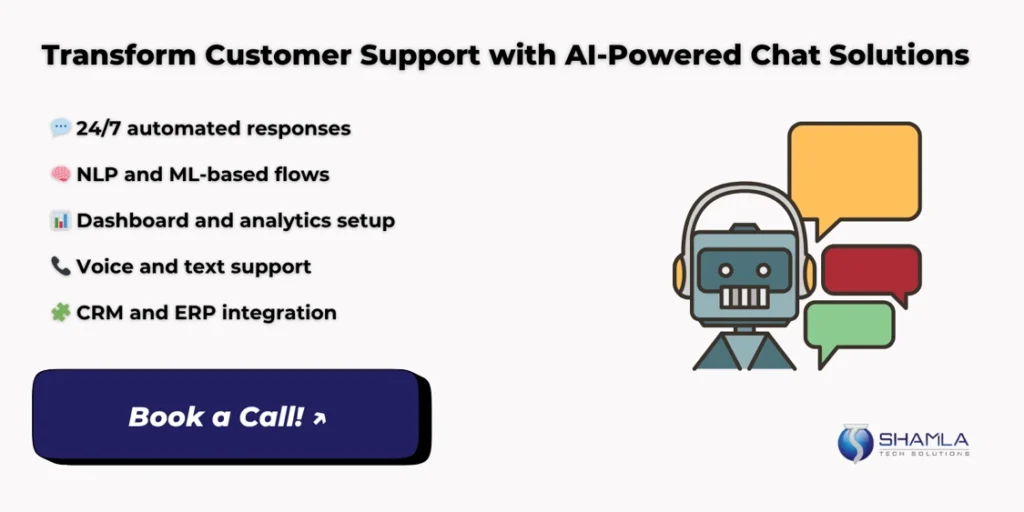Conversational AI is changing the way businesses engage with customers – making it faster, easier, and more personal than ever. In 2025, more firms are using cloud-based chat engines, training models on real user conversations, and cutting support staff time. These tools run on secure servers and learn from past chats.
We will cover seven industries where conversational AI drives big gains: banking, healthcare, insurance, online shopping, finance, travel and hotels, and education. In each case, bots answer questions, guide users, and speed up tasks. This shift to chat systems shows how smart software can save time and make services better with fewer people handling routine work.
7 Industries Disrupted by Conversational AI in 2025
1. Banking: Smarter Financial Interactions with AI
Major banks now run automated identity checks, fraud spotting, and instant help. They use secure chat systems that check documents and confirm IDs without human review. This conversational AI in banking cuts approval times by up to 70% without extra staff. The chat system also handles real-time answers on account balances, loan rates, and card issues, replacing long hold times. By storing every question and answer, banks improve model responses over time.
When unusual transactions appear, the system flags them for review, reducing losses. This conversational AI in banking also sends personalized alerts and guides users through PIN resets or payment setups in a single chat. As part of conversational AI for business tools, these systems tie into core banking software via APIs to pull transaction data and push updates. They also generate audit logs and compliance records automatically. With round-the-clock availability, this conversational AI in banking lets banks keep support centers lean while meeting customer demand at any hour. Data stays safe thanks to end-to-end encryption and role-based access controls. Banks train models with anonymized logs to boost accuracy on finance-specific queries.
Multilingual support handles English, Spanish, and regional languages. Developers update bot scripts monthly to match new regulations and products. Teams integrate voice bots that convert speech to text, letting customers speak their requests and get fast replies. Others use screen-sharing bots to walk users through mobile apps step by step.
2. Healthcare: AI That Listens, Learns, and Assists
Clinics now use chat systems to field patient questions and log symptoms. These bots link to health records and suggest care steps. This conversational AI in healthcare gives fast answers on drug dosages, side effects, and test results. Patients type symptoms into chat and get guidance on next steps, reducing clinic calls. By storing patient chats, doctors refine models to spot warning signs earlier.
When mental health issues arise, the bot asks screening questions and can connect users to counselors. This conversational AI in healthcare handles appointment booking and prescription refills without staff calls. The system ties into scheduling software via APIs, sending reminders and adjusting slots in real time. Doctors review summary logs before visits, saving prep time. As part of conversational AI for business suites, these bots run on secure servers that meet health data rules. They use encryption and strict login checks to keep records safe.
Teams update content with new treatment guidelines monthly to match medical standards. Some hospitals add voice bots so patients can speak queries by phone. Others use multimedia bots that show care videos or diagrams in chat. Admins monitor usage metrics from conversational AI for business dashboards to guide training and resource planning.
3. Insurance: Claims, Quotes, and Coverage via Bots
Policy providers now use bots to file claims and answer coverage queries. Customers upload photos of damage in chat, and the bot fills claim forms instantly. This conversational AI for insurance cuts paperwork to zero. The bot also explains policy terms, limits, and renewal dates in clear steps. By logging every interaction, insurers train models to spot fraud and speed approvals.
When claims need human review, bots route cases with detailed chat logs. This conversational AI for insurance also sends quote estimates and policy updates via WhatsApp and SMS. Agents use live chat feeds to join or hand off conversations. Integrating with billing systems through APIs, the bot can process payments and send receipts in real time.
As part of conversational AI for business platforms, these bots meet data rules and encrypt customer files. Teams adjust scripts monthly to reflect new rates and compliance changes. Lead teams use chat bots to nurture prospects, sending tailored policy options based on user answers. Managers review conversational AI for business reports weekly to refine outreach.
4. Retail & E-Commerce: Converting Conversations to Conversions
Online stores use chat tools that act as personal shoppers. These bots pull product details from stock databases, check prices, and show in-stock counts in real time. Shoppers ask about colors or sizes, and the bot replies instantly with links. When users add items, the bot suggests matching products or bundles to boost sales.
Developers plug AI chat widgets into checkout flows so the bot can offer discounts or free shipping upsells. This conversational AI for business logs each chat, tying queries back to product IDs for sales analysis. Teams review chat transcripts in dashboards to spot popular items and adjust offers. The system links to order-tracking APIs, so customers get live shipping updates without leaving chat.
If an item is out of stock, the bot recommends similar choices or alert opt-ins when stock returns. Brands use these insights to plan inventory and marketing pushes. By running on secure cloud servers with auto-scaling, the bot handles traffic spikes during sales without lag. This conversational AI for business keeps shoppers engaged and cuts cart abandonment by answering questions at each step.
5. Finance: From Wealth Advice to Account Alerts
Investment platforms deploy robo-advisors that ask users about goals, risk levels, and timelines. The bot runs algorithms to build portfolios, then explains choices in clear steps. Customers ask for net worth estimates, and the bot pulls data from linked accounts via secure APIs. It also tracks credit scores, alerts users about dips, and sends tax-due reminders on schedule.
For complex queries, the system hands chats off to human agents, showing the agent the full chat history. This conversational AI in finance lets firms offer 24/7 support with local language options. Developers train models on market trends so bots can flag unusual spending or suggest portfolio tweaks. All logs feed into compliance reports automatically. When clients ask about loan rates or mortgage options, the bot runs rate-comparison scripts and returns clear tables.
By integrating with trading engines, it even places simple buy or sell orders on command. This conversational AI in finance drives account growth and cuts service costs. Team leads use analytics from the bot to refine scripts and update investment rules monthly. Running on encrypted servers, it meets finance-industry data rules. This conversational AI in finance keeps both users and regulators satisfied. As part of their toolkit, firms bundle this as a core conversational AI for business solutions.
6. Travel & Hospitality: 24/7 Concierge at Scale
Airlines and hotels deploy chat services that handle flight changes and room bookings. Passengers text the bot when a delay strikes; it searches alternate flights and books seats. Guests ask for room upgrades or late checkout and get real-time rates. The bot speaks multiple languages, switching scripts to match user locale. It also links to mapping APIs to suggest nearby restaurants or attractions.
By routing high-volume tasks to chat, chains cut front-desk lines and free staff for VIP requests. This conversational AI for business records each request and service outcome, feeding data into CRM tools. When demand peaks like holiday seasons, the system auto-scales to handle extra chats without slowing. It also sends check-in reminders and mobile key links before arrival. Teams update service templates weekly to reflect new property features or travel rules.
Integration with payment gateways lets guests settle bills directly in chat. This boosts on-site spend and speeds departure. Secure cloud hosting and role-based access keep guest data safe. By automating routine tasks, hotels focus on personal touches for high-value clients. This conversational AI for business offers instant help worldwide, day or night.
7. Education: AI Tutors That Never Sleep
Schools and online courses use chat systems that adapt lessons to each student. When a learner types a question, the bot pulls explanations from lesson scripts and examples. It tracks errors across quizzes and adjusts follow-up questions to target weak spots. Students ask for homework hints, and the bot guides them step by step without giving direct answers.
University campuses deploy bots that handle enrollment queries, campus maps, and fee payments. These systems tie into student information systems via secure APIs to show class schedules or grades. In live sessions, the bot fields routine questions, freeing instructors to focus on complex topics. By logging every interaction, educators see which topics need review based on chat volume. This conversational AI for business runs on cloud servers and meets privacy rules.
Schools update content each semester to reflect new materials. Some bots link to video libraries, popping relevant clips into chat. Others send study-reminder alerts before exams. With 24/7 access, learners get help on their schedule, boosting study time and outcomes. This conversational AI for business keeps students engaged and eases administrative work.
How Shamla Tech Can Build Your Future-Ready Conversational AI Chatbot
Shamla Tech builds conversational AI for business systems using language processing and machine learning models. Our team trains bots in real time with live data feeds, tuning them for clear replies across languages. We link bots to customer apps through APIs for instant data fetch. Deployment runs on secure cloud servers that can grow with traffic. With model updates and usage logs, we ensure high accuracy and smooth chat flow.
Clients get a white-glove setup with custom intents and fallback flows for each use. Our team builds multi-language support into the secure cloud engine, covering major and local tongues. We offer API links to CRM and analytics, plus real-time monitoring dashboards and logs. Auto-scaling keeps services live under load. With guided model retraining and version control, you stay ready for demands. This premium plan delivers future-proof conversational AI for business.
Conclusion
Across banking, healthcare, insurance, retail, finance, travel, and education, conversational AI systems automate key tasks, cut response times, and significantly boost online sales. Companies see faster case handling and lower support costs, driving measurable return on investment. Customers get instant answers and guided workflows, raising satisfaction and loyalty. Every industry now thrives.
Shamla Tech is an AI chatbot development company that delivers custom AI chatbots for enterprises, handling intents and user journeys with real-world data training. As a leader in conversational AI for business, we integrate bots with CRMs and analytics platforms via secure APIs. Our solutions have cut support loads, increased conversions, and streamlined workflows for clients worldwide.
Ready to streamline your business with a custom AI chatbot?
Contact us and deploy your conversational AI for business today!





